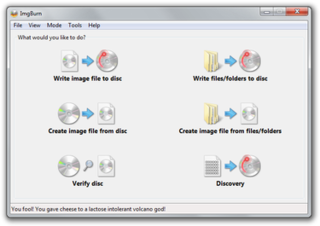Related Research Articles

An optical disc is a flat, usually disc-shaped object that stores information in the form of physical variations on its surface that can be read with the aid of a beam of light. Optical discs can be reflective, where the light source and detector are on the same side of the disc, or transmissive, where light shines through the disc to be detected on the other side.
Universal Disk Format (UDF) is an open, vendor-neutral file system for computer data storage for a broad range of media. In practice, it has been most widely used for DVDs and newer optical disc formats, supplanting ISO 9660. Due to its design, it is very well suited to incremental updates on both write-once and re-writable optical media. UDF was developed and maintained by the Optical Storage Technology Association (OSTA).

In computing, an optical disc drive (ODD) is a disc drive that uses laser light or electromagnetic waves within or near the visible light spectrum as part of the process of reading or writing data to or from optical discs. Some drives can only read from certain discs, while other drives can both read and record. Those drives are called burners or writers since they physically burn the data onto on the discs. Compact discs, DVDs, and Blu-ray discs are common types of optical media which can be read and recorded by such drives.
Mount Rainier (MRW) is a format for writable optical discs which provides the packet writing and defect management. Its goal is the replacement of the floppy disk. It is named after Mount Rainier, a volcano near Seattle, Washington, United States.
An optical disc image is a disk image that contains everything that would be written to an optical disc, disk sector by disc sector, including the optical disc file system. ISO images contain the binary image of an optical media file system, including the data in its files in binary format, copied exactly as they were stored on the disc. The data inside the ISO image will be structured according to the file system that was used on the optical disc from which it was created.
Optical disc authoring, including CD, DVD, and Blu-ray Disc authoring, is the process of assembling source material—video, audio or other data—into the proper logical volume format to then be recorded ("burned") onto an optical disc. This act is sometimes done illegally, by pirating copyrighted material without permission from the original artists.

DVD-RAM is a DVD-based disc specification presented in 1996 by the DVD Forum, which specifies rewritable DVD-RAM media and the appropriate DVD writers. DVD-RAM media have been used in computers as well as camcorders and personal video recorders since 1998.

K3b is a CD, DVD and Blu-ray authoring application by KDE for Unix-like computer operating systems. It provides a graphical user interface to perform most CD/DVD burning tasks like creating an Audio CD from a set of audio files or copying a CD/DVD, as well as more advanced tasks such as burning eMoviX CD/DVDs. It can also perform direct disc-to-disc copies. The program has many default settings which can be customized by more experienced users. The actual disc recording in K3b is done by the command line utilities cdrecord or cdrkit, cdrdao, and growisofs. As of version 1.0, K3b features a built-in DVD ripper.

The Blu-ray Disc Association (BDA) is the industry consortium that develops and licenses Blu-ray technology and is responsible for establishing format standards and promoting business opportunities for Blu-ray Disc. The BDA is divided into three levels of membership: the board of directors, contributors, and general members.

CDBurnerXP is an optical disc authoring utility for Windows 2000 and later, written mostly in Visual Basic .NET as of version 4, released in September 2007. It has international language support. The software is available to download in both 32-bit and 64-bit variants.
InCD is a packet writing software developed by Nero AG for Microsoft Windows.

DVD recordable and DVD rewritable are a collection of optical disc formats that can be written to by a DVD recorder and by computers using a DVD writer. The "recordable" discs are write-once read-many (WORM) media, where as "rewritable" discs are able to be erased and rewritten. Data is written ('burned') to the disc by a laser, rather than the data being 'pressed' onto the disc during manufacture, like a DVD-ROM. Pressing is used in mass production, primarily for the distribution of home video.

ImgBurn is an optical disc authoring program that allows the recording of many types of CD, DVD and Blu-ray images to recordable media. Starting with version 2.0.0.0, ImgBurn can also burn files and data directly to CD or DVD. It is written in C++. It supports padding DVD-Video files so the layer break occurs on a proper cell boundary.
Drive Letter Access (DLA) is a discontinued commercial packet writing application for the Microsoft Windows operating system that allows optical disc data storage devices to be used in a manner similar to floppy disks. DLA is a packet writing technology for CD and DVD media that uses the UDF file system.
Windows Vista has many significant new features compared with previous Microsoft Windows versions, covering most aspects of the operating system.

HD DVD is an obsolete high-density optical disc format for storing data and playback of high-definition video. Supported principally by Toshiba, HD DVD was envisioned to be the successor to the standard DVD format, but lost to Blu-ray, supported by Sony and others.
As of 2021, multiple consumer-oriented, optical-disk media formats are or were available:
The ISO Recorder Power Toy is a shell extension that uses native Windows XP functions to add a new CD recording option to Windows XP's context menus, a CD burning software for Windows XP, Windows Server 2003, Windows Vista and Windows 7. The software, from hard drive folders, can create an ISO 9660 image, and burn an ISO 9660 image file to CD or DVD.
Live File System is the term Microsoft uses to describe the packet writing method of creating discs in Windows Vista and later, which allows writeable optical media to act like mass storage by replicating its file operations. Live File System lets users manage files on recordable and rewriteable optical discs inside the file manager with the familiar workflow known from mass storage media such as USB flash drives and external hard disk drives.
Macgo Mac Blu-ray Player is a proprietary Blu-ray Disc media playing software, first released in 2011 by Macgo Inc. It provides playback functionality for Blu-ray Discs, DVDs, and other media formats for Mac and Microsoft Windows. Free trial versions are available for both Mac and PC platforms. It is also a media player for playing Blu-ray Disc/Folder or ISO files on Windows 8.1/8/7/Vista/XP.
References
- ↑ Windows XP Technical Overview
- ↑ Burning A DVD In Vista
- ↑ Random rewriting on a DVD +RW?
- ↑ "Description of the Image Mastering API v2.0 (IMAPIv2.0) update package that is dated June 26, 2007 (MSKB932716)". Microsoft Support. Microsoft. 11 October 2007. Retrieved 12 December 2007.
- 1 2 "Description of the Image Mastering API v2.0 (IMAPIv2.0) update package in Windows Feature Pack for Storage 1.0". Microsoft Support. Microsoft Corporation. Retrieved 17 June 2010.
- ↑ "About IMAPI". Microsoft Developer Network: Image Mastering API. Microsoft Corporation. Retrieved 12 December 2007.
- 1 2 3 4 "What's New (Windows)". Microsoft Developer Network: Image Mastering API. Microsoft Corporation. Retrieved 12 December 2007.
- 1 2 3 "Optical Platform: Windows Vista and beyond" (Microsoft PowerPoint). Microsoft WinHEC 2006. Microsoft Corporation. 2006. Retrieved 17 June 2010.
- ↑ Burg, David (16 January 2007). "Disabling IMAPI in Vista". MSDN Forums: Optical Platform Discussion. Microsoft Corporation. Retrieved 17 June 2010.
There is no per-se disabling of IMAPI in Vista. IMAPI in Vista is a DLL (unlike XP where IMAPIv1 is a service).
[ permanent dead link ] - ↑ "IFileSystemImage::ImportSpecificFileSystem (Imapi2fs.h) - Win32 apps". 22 February 2024.